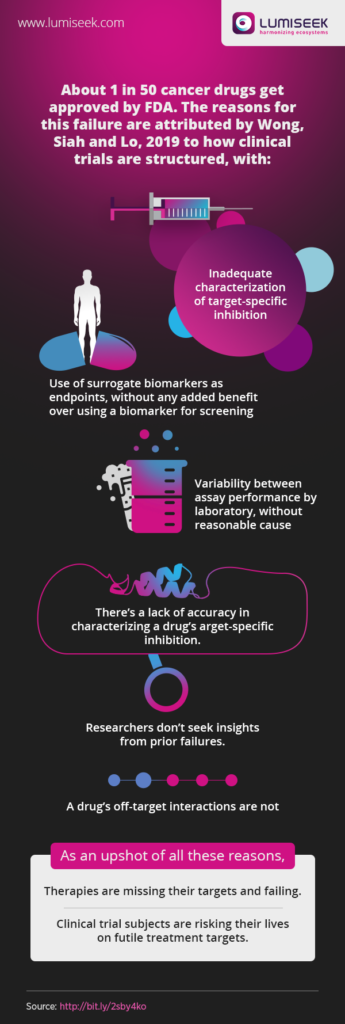The war against cancer is being fought at many levels, with newer drugs targeting novel targets joining the queue to go through clinical trials. However, according to a recent research study, the failure rate of clinical trials in oncology stands at 97%, due to issues related to a lack of efficacy with some drugs and unacceptable toxicity with others.(Wong, Siah and Lo, 2019). The study also found that many of the cancer drugs studies are found to work via off-target effects, as their Mechanism of Action (MOA) is poorly understood in many cases, leading to some of the following issues:
- Inadequate characterization of target-specific inhibition
- Use of surrogate biomarkers as endpoints, which do not provide added benefit over using a biomarker as a criterion for screening
- Interlaboratory variability between assay performance, without reasonable cause

Following are some guidelines that can potentially improve the FDA approval rate in the future.
- Increase accuracy of the characterization of target-specific inhibition by the drug.
- Derive precise, reliable and informative results from the biomolecular interaction analysis and understand the drug’s MOA better.
- Be highly selective when conducting biomolecular interaction assays.
- Stay aware that some key drug targets, which were previously thought to be essential for cancer treatment, have turned out be non-essential for the survival of cancer cells.
- Some other cancer drugs turned out to have an MOA which owes its efficacy to off-target toxicity or interactions and not because they are attacking the specifically targeted genes, proteins, or tissues cancer cells rely on for their survival and growth.
- Knowing the MOA of some known and potent anti-cancer agents could help us discover new cancer targets to design new and better drugs.
- Many times, promising drug candidates end up as failures, as the right clinical trial has not been designed to test them.
- Demand highly reproducible research.
- Ensure that the evidence of a drug’s efficacy is carefully evaluated and the rationale for targeting a particular target is ratified.